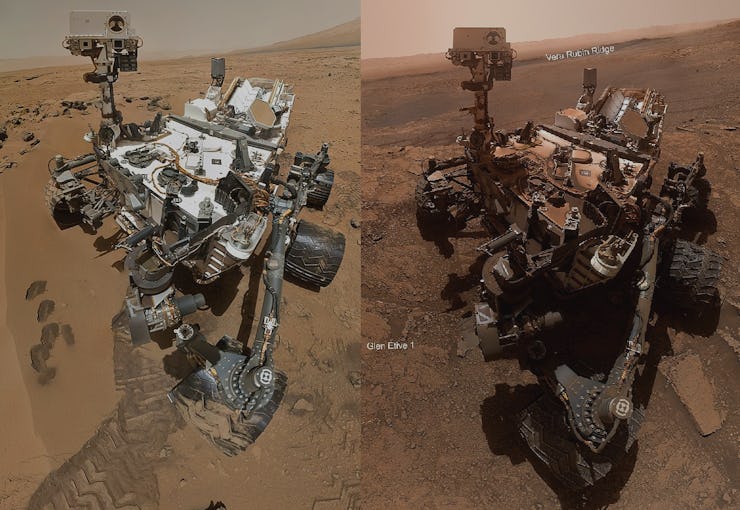
Curiosity has seen some things.
Mars rover selfie reveals the toll of life on Mars
NASA’s Curiosity rover has spent a long seven years on Mars, roaming the Red Planet to search for signs of ancient life.
by Passant RabieNASA’s Curiosity rover has spent a long seven years on Mars, roaming the Red Planet to search for signs of ancient life.
The time spent battling the harsh element of Mars, with its freezing temperatures, harsh winds and dusty storms, has left quite the impact on the car-sized robot.
A side-by-side comparison of an image the rover had snapped shortly after it landed on the Red Planet and one the robot took back in January highlights its shocking transformation.
INVERSE IS COUNTING DOWN THE 20 MOST UNIVERSE-ALTERING MOMENTS OF 2020. THIS IS NUMBER 9. See the full list here.
NASA's Curiosity is a little dusty after seven years on Mars.
The photo was posted on the image sharing website Imgur with a 'before' shot. It later landed on the space community board on Reddit, climbing up the ranks with tens of thousands of upvotes.
Curiosity was launched into space in November, 2011 and landed on Mars on August 5, 2012. It followed in the tracks of its predecessors Sojourner, Opportunity, and Spirit, and will soon be followed by the Perseverance rover, which is scheduled to land on Mars in February, 2021.
Throughout its time on Mars, the Curiosity rover is fond of taking selfies using its extended robotic arm with a camera attached to its end.
In one of its latest communications with Earth, the Curiosity rover snapped an image of itself on Mars on October 11, 2019. And the comparison between Curiosity’s most recent selfie with ones it had snapped earlier on in its journey shows the toll the Red Planet has taken on the robotic explorer.
Curiosity has had to navigate through Mars' rocky surface, with dried up lake beds, craters and volcanoes. The red planet is also covered in red dust, which is often blown by rough Martian winds into tornado-like dust storms that are sometimes so large they can be seen from Earth, according to NASA.
The robot was sent out on a two-year mission to find out whether Mars ever had the right environmental conditions to support life during its early history.
Since it landed on Mars in 2012, Curiosity has been roaming the Gale Crater and discovered a lake that may have contained water billions of years ago and an environment that could have possibly supported microbial life.
The rover has been through a lot and it shows, but it should not be discouraged by its fading shine.
INVERSE IS COUNTING DOWN THE 20 MOST UNIVERSE-ALTERING MOMENTS OF 2020. THIS IS NUMBER 9. READ THE ORIGINAL STORY HERE.
This article was originally published on